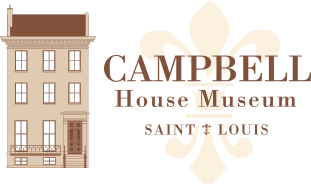
A couple of weeks ago, we conducted one of our Lucas Place Walking Tours, and we had a load of fun sharing the history of our neighborhood with such an enthusiastic group. Why, you may ask, would anyone be interested in the history of this old street? Easy: Aside from its significance as the first exclusive neighborhood in St. Louis, the people who lived here were some of the most influential in the region. Much of the history of St. Louis is entwined with the people who lived here.
Background
Cue this song.
In 1850, siblings James Lucas and Ann Lucas Hunt (sound familiar?) planned a residential development on farmland they had inherited from their father. This new “suburban” neighborhood was west of the city, and it stretched along what is now Locust Street between 13th and 16th Streets.
How was this new ‘hood exclusive?
- They were expensive. $100 per front foot. Lots were at minimum 25 feet wide, and nobody bought just one lot. This price excluded all but the wealthiest of buyers.
- It was remote, about 1 mile west of the Mississippi River.
-

Lucas Place, circa 1875. Deed restrictions were on the property, and this was unusual back then. Among them: houses were to be built 25 feet away from the street, thus producing front yards (houses were typically built right on the sidewalk), and the following businesses were prohibited: groceries, apothecaries, restaurants, and theatres.
- Lucas Place was offset from the existing street grid with Missouri Park at the east end of the street, thus serving as a barrier between the elegant homes and the hustle and bustle of the city.
- Lots were a generous 155 feet deep. (That’s only 5 feet shy of the width of a football field.)
- “Place” instead of “avenue” or “street” implied an important destination, which reinforced the exclusivity of the homes and residents.

Buildings
Our Campbell House was the first one built on the street in 1851, and it was probably the smallest one in the neighborhood. Homes on the north side of Lucas Place were much larger. Case in point, #1515, the Lucas-How residence. It sat across from Robert and Virginia’s, and it was roughly twice as large as Campbell House. We have a generous 10,000 square feet, and the Lucas-How house was probably about 20,000 square feet. (For comparison, new homes built in 2010 came in around 2392 square feet.)
Lucas Place was the place to be, and it represented the beautiful side of our fair city. So it should come as no surprise that whenever important guests were in town, they were paraded through the neighborhood. The homes of some of the most influential men and women in St. Louis were big and pristine with immaculately maintained yards, and the whole street was lined by MARBLE sidewalks. (Really.) Lucas Place was a sight to see.

In addition to the residences, some businesses that were not prohibited by the deed restrictions were on the street, including the original home of the St. Louis Art Museum and Mary Institute (now called Mary Institute Country Day School.) The first public high school west of the Mississippi sat behind Campbell House at 15th Street and Olive, and Washington University was two blocks away on Washington Avenue.
Who
Aside from James Lucas (#1515) and sister Ann Lucas Hunt (#1706), some big muckety-mucks were Campbell neighbors, including:
- Henry Hitchcock, the first dean of Washington University. (#1507)
- Amadee Valle, Missouri congressman and friend to Abraham Lincoln and Henry Shaw. (#1516)
- General William Harney, the commander of the Army’s Department of the West during the Civil War. (#1428)
- Trusten Polk, Governor of Missouri (1856) and U.S. Senator (1857-1863). (#1400)
- John How, Mayor of St. Louis, 1853-1857. (#1515 before James Lucas moved in.)
- Henry Kayser, city engineer who designed St. Louis’ first plumbing and sewer systems. (#1420)

Demise
The deed restrictions expired 30 years after the land was initially purchased from the Lucases. Since many of the houses were built in the 1850s and 1860s, the covenants were expiring in the 1880s and 1890s. This is when houses were converted to businesses and boarding houses, and the wealthy residents moved to more fashionable neighborhoods farther west, including Portland Place, Lafayette Square and Vandeventer Place.
The park barrier between Lucas Place and the rest of the city was removed in the 1890s, and Lucas Place was renamed Locust Street. The area evolved into an industrial neighborhood, with warehouses and factories replacing the housing stock. Campbell House remained as the last home from Lucas Place.
Here are a few more notable images of Lucas Place….



